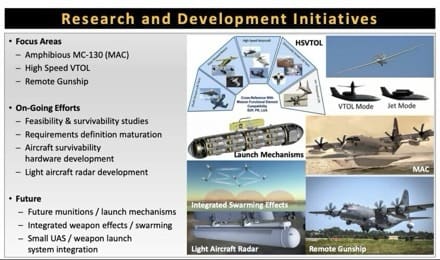The U.S. Air Force Offensive small Unmanned Aerial Systems (sUAS) System Program Office (SPO) has issued a Request for Information to Industry to conduct market research to determine Industry’s ability to provide capabilities supporting the Air Force Special Operations Command’s (AFSOC) Adaptive Airborne Enterprise (A2E) concept within 24 – 36 months.
What they are after is a Group 3 sUAS capable of internally carrying and deploying Group 2 sUAS equipped with an Intelligence Surveillance and Reconnaissance (ISR) payload. Essentially, a drone capable of being launched from a C-130 which carries and deploys a swarm of even smaller drones.

This is one of three distinct RFIs to be issued that will cover the sUAS platform needs for fielding Adaptive Airborne Enterprise (A2E) capabilities within 24 – 36 months of this RFI.
The SPO intends to release three distinct RFIs, each covering a specific A2E sUAS capability, detailed below. The SPO is seeking Industry responses to help inform how it can provide AFSOC with air-launched sUAS capabilities that integrate Group 2 Air-Launched ISR systems, Group 3 Air-Launched Swarm Carrier systems, and Group 3 Air-Launched Signature Managed systems within the A2E architecture (see Appendix A, Figure 1) while complying with a Modular Open System Approach (MOSA). Specifically, the SPO will be seeking responses for each of the three capabilities below via three separate and distinct RFIs:
• Group 2 ISR – To be internally carried and air-launched via Common Launch Tube (CLT) from a Group 3 Swarm Carrier.
• Group 3 Swarm Carrier – To be deployed from a C-130 as an air-dropped, palletized effect, internally carrying and able to launch Group 2 ISR sUAS from CLTs.
• Group 3 Signature Managed – To be air-launched from a Group 5 system, act as a C2 node in a network/swarm of sUAS and send data from the contested/denied environment to the Joint Force.
Solutions must align with MOSA design principles and be cost-effective for the government. They must also be compatible with an Autonomous Government Referenced Architecture and the software chosen to support that architecture. Finally, solutions must demonstrate a maturity level and production capacity that confidently conveys the ability to deliver scalable quantity within 36 months.
RFI responses are due no later than (NLT) 1700 EST (sic) on August 09, 2024.
Read the details at sam.gov.

